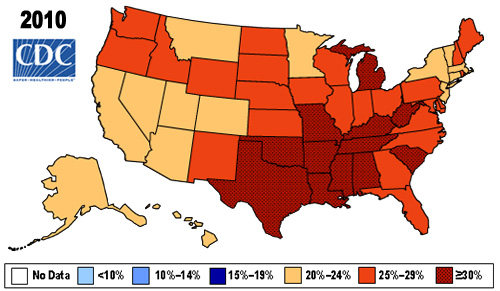The Landscape of Adult Obesity: State Rates are Still High
In 2010, no state reported adult obesity prevalence lower than 20 percent and 12 states reported an obesity prevalence of 30 percent or more. The obesity landscape over the past 10 years has changed dramatically. In 2000 no states reported obesity prevalence of more than 30 percent.

The 2010 BRFSS data confirms that no state met the nation's Healthy People 2010 goal to lower obesity prevalence to 15 percent within the past decade. "State obesity rates are still high," said CDC Director Thomas Frieden, M.D., M.P.H. "If we lose sight of the seriousness of obesity as a public health issue, we run the risk of an increasingly unhealthy country."
But the changes won't happen overnight. There's no single or simple solution to the obesity epidemic. "It will take time to win in the fight against obesity," said Dr. William Dietz, director of CDC's Division of Nutrition, Physical Activity and Obesity. "We must continue to change the environments that increase food intake and make it hard for people to be active. By doing this, we're investing in our children and grandchildren so they won't have to carry this serious and costly burden."
CDC supports a number of initiatives that helps states, territories, tribes and communities combat both obesity through science-based nutrition, physical activity and obesity programs. Currently the focus is creating changes that support healthy eating and active living where Americans live, work, learn and play.
Learn what you can do to help address the problem of obesity. Visit http://www.cdc.gov/obesity/data/trends.html for helpful tips and to review rates in all states.